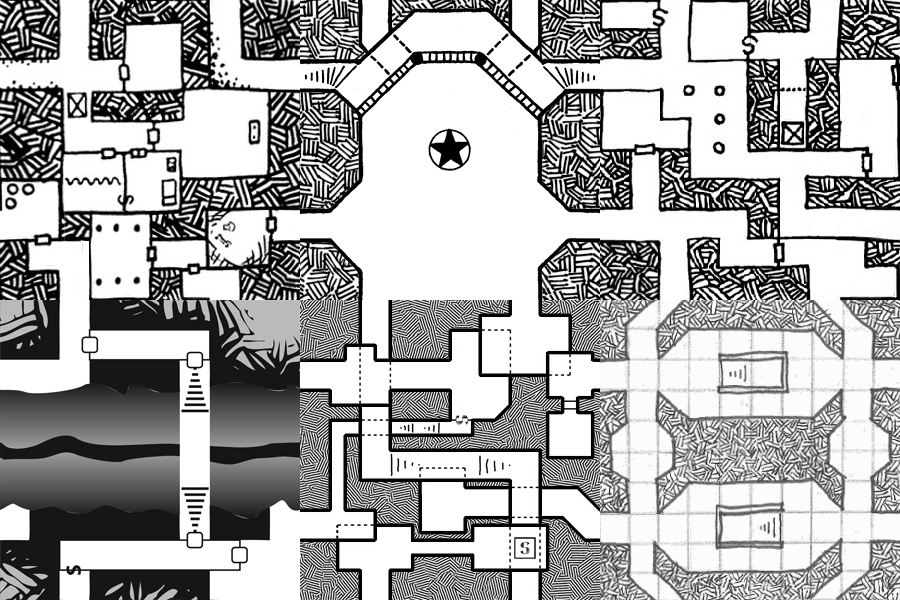Dungeon Geomorphs, as re-popularized by Dyson’s Dodecahedron, are dungeon squares that can be freely combined to make new maps. You can draw from the rich collection that already exists and create your own that are compatible. You can create dungeons from these by printing and assembling the geomorphs or by using an online tool like Dave’s Mapper.
Dungeon World 1e is the geomorph set of fantasy PbtAs, thanks to it being one of the first TTRPGs to use the Creative Commons license. You can cut it out and reassemble it, build on it as desired. Here are some of the many works that are compatible with Dungeon World 1e:
- Supplements: A Book of Beasts, Class Warfare, Drowning & Falling, A Folio of Followers, Freebooters on the Frontier, Funnel World, Mounted Combat, Oracle Deck, One Shot World, The Perilous Wilds, Terrors of the Ancient World, Unlimited Dungeons, and Urban/Modern/Fantasy.
- New settings: Absurd World, Adventures on Dungeon Planet, Bodil’s Gap (my capsule review), Chaos Worlds, Doublecrossed World, Fourth World, Grim World, Inverse World, Planarch Codex: Dark Heart of the Dreamer, Shadows of Umberto, and The Wyrd of Stromgard (my capsule review).
- New playbook sets: Alternative Playbooks, Class Bundle 2, Incomplete Adventurer, Missing Paths, Playbook Collection, and many more playbooks and compendium classes.
- Community documents: Dungeon World Syllabus, Dungeon World Guide, The Inexhaustive List of Dungeon World Questions, etc.
And like any TTRPG of course, designers have created adventure modules for Dungeon World 1e, such as The Bloodstone Idol, Indigo Galleon, Servants of the Cinder Queen, The Slave Pit of Drazhu, Within the Devil’s Reach. (DW can also easily work with AD&D modules, 3e modules, OSR adventures, etc.)
Fans of DW 1e also pioneered a unique type of barebones “module”: one- and two-page starters that provide inspiration. Check out Perilous Deeps, 20 Dungeon Starters, Tygart Dungeon World Starters, and my own collection and expansion of these, Improv Almanac.
Taken together, this is clearly a rich source of supplemental material, perhaps the broadest and deepest third-party support of any PbtA game yet made.
While there have been many hacks of Dungeon World that take it in new directions, there are at least three clones designed to be largely compatible with community content:
- Unlimited Dungeons
- Maze World
- Uncommon World with Fantastic Worlds, my own clone.
So you too want to make a game that is compatible with Dungeon World’s first edition, in order to leverage its rich third-party support and the years of experience the community has had in refining it. What is the core of its API (Application Programming Interface)?
- You’ll need the classic six abilities, which are the foundation of every playbook and almost every move: Strength, Constitution, Dexterity, Intelligence, Wisdom, and Charisma. If you want to get rid of the 3-18 values and use only the modifiers, that’s not hard: re-word character creation, leveling up, and some prices that depend on the 3-18 value of Constitution. (Bonus: these attributes make things simpler for migrating folks from 5e.)
- You’ll want to keep the move names the same, as many playbooks and supplemental materials reference them. But you can rewrite the text of the moves a lot. Check out the Dungeon World Patch Kit for alternatives. The only move for which you’ll need to keep the basic structure is Discern Realities, because many playbooks add a specific question or two to it. (Class Warfare, from Johnstone Metzger, proved invaluable to me to do that analysis.)
- You’ll need to keep hit points, which are central to the design of characters, monsters, weapons, etc. (And another great on-ramp from 5e.) But you could add a move if you wanted to make HP more thematic. Some hacks re-word Last Breath to occur when you fall to 0 hit points; you could easily add a move for what happens when HP falls below half Max HP or when it drops by 8 or more, for instance. You could adopt and modify a move like Homebrew World’s Take Damage, as well.
Let’s say that you want to make a DW 1e clone that is more like 5e (which was published after DW 1e). You can easily find the playbooks you want that line up with 5e. And now that the core rules of both 5e and 5.24 are licensed under the Creative Commons, you can bring over a lot more material without fears of copyright infringement or revocable licenses. For example, here’s a DW skill system compatible with 5e as an example of the type of hybridization that is possible now.
The more you drift from DW1, the more you will want to provide conversion notes and advice so that players can still use community content with your clone.
DW1 and its community content form a rich set of tools that can create new ways to explore all those geomorph dungeons. I look forward to seeing what you create!
Photo credit: Dave’s Mapper, Stuart Robinson, Nate McD, Stonewerks, FrDave, Brutus Motor, Rodger Thorm.


